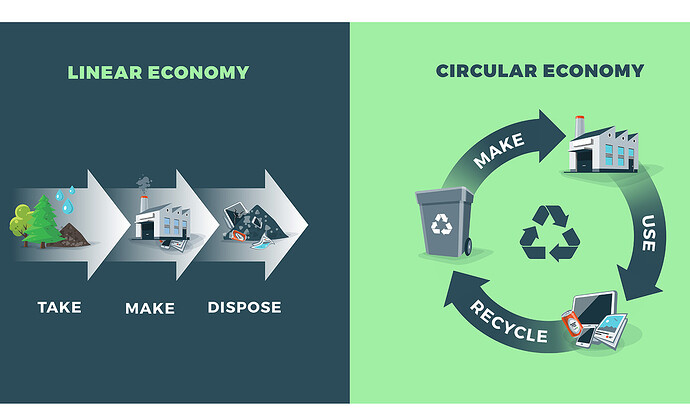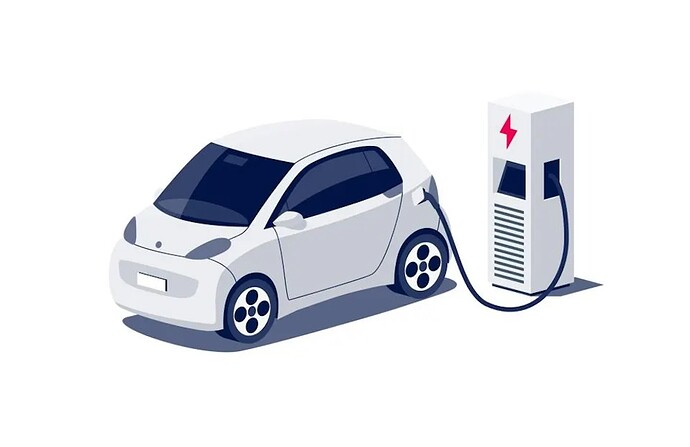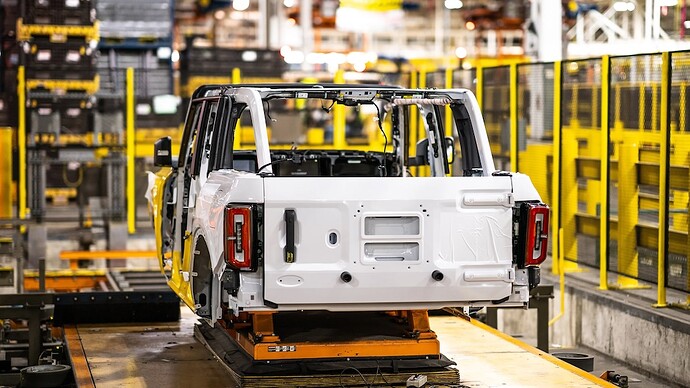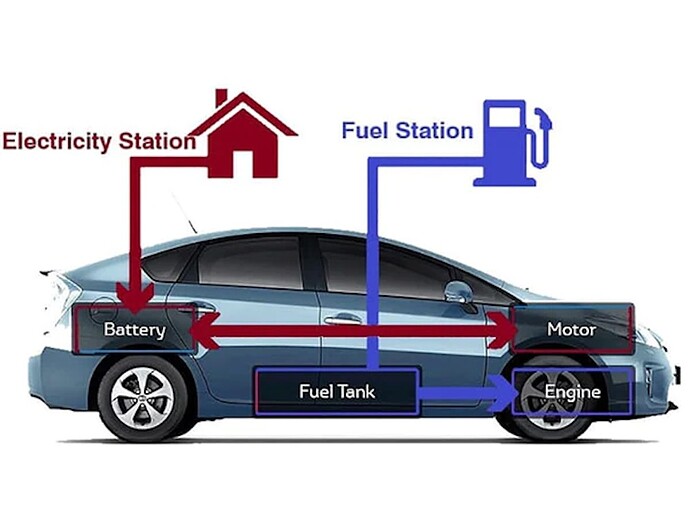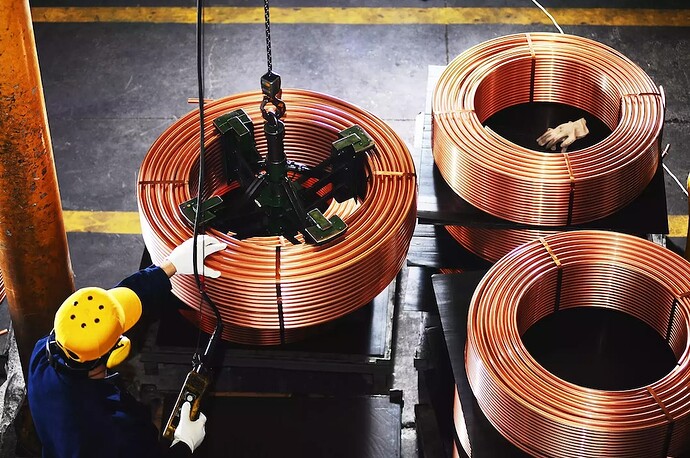Illustration: Inge Snip
1. Introduction:
If we look at the history of the modern world, the global landscape has been shaped more by industrial revolutions and market economy than by political ideas. Ever since the first industrial revolution in the late 18th century; the world has been on the path of development that significantly changed every aspect of human lives. But the profound change went beyond that, and the industrialisation, new economic systems, and demand for materials and products had formed the political, social, and environmental reality we live in today. Although humanity is in the middle of the fourth industrial revolution, much of the global economy still functions according to industrial principles dating from the early 20th century. The car industry is one of the best examples of that claim. We see that automotive technology advances at a fantastic pace. However, the economy model is still pretty conservative, especially in terms of sustainability, circular economy, recycling, and reusing components and materials. In order to continue thriving, the car industry needs to reinvent itself along those lines. Let’s discuss this further.
Photo Credit: MotorBeam
2. The Difference Between Linear And Circular Economy In the Car Industry
The first automobile with an internal combustion engine was patented in 1886, which interestingly is the time of the second industrial revolution, which introduced the widespread use of steel, electricity, rubber, and petroleum. All of which found its way into the automobile as a contraption. By the end of the Second Industrial Revolution (1914), the automobile was already a widely accepted device that changed the urban landscape, making horse-drawn carriages obsolete with unmatched speed, range, and abilities. However, what the automobile also introduced was the most significant and most enduring example of a linear economy. Characterised by the “Take-Make-Dispose” mantra, the linear economy, in fact, paved the way for the evolution of automobile and mobility in general. By producing more and more advanced designs, car companies made each previous model outdated, forcing the customers to keep buying new and disposing of old cars every few years. The result is enormous raw materials, oil consumption, and hyper-production of vehicles and designs, lasting over 100 years. At the moment, it is estimated that there are over 1.47 billion cars in the world, with annual production of over 84 million vehicles (2023). At the same time, tens of millions of discarded, broken and obsolete vehicles are rotting at scrap yards globally. Seeing just how enormous the automotive market is and how many cars are out there, it is easy to understand why the linear economy model has no future in the car industry.
Photo Credit: Linkedin
The circular economy concept is not new but has become increasingly relevant in modern times. The ideas of recycling, reusability, dematerialisation, refurbishing and sustainability determine this model. In an ideal scenario, the product will have a longer life and be easily refurbished, reused or upgraded for the next generation. It would be made out of recycled materials, and all valuable materials could be harvested in the recycling process. Such production will be 100% sustainable, and its environmental effects will be minimalised. Since the introduction of the circular economy concept, there have been some improvements in applying it to the car industry, but it still needs to be completed. The car companies are open to ideas per se, but there are a lot of challenges that need to be overcome. Some of them are related to the production methods, some to energy sources, and some to current technology. With the introduction of electric vehicles and their widespread use, the in-car industry’s circular economy moved one step towards sustainability, distancing itself from fossil fuels. But abandoning petrol as the primary energy source is just the beginning and is not a solution.
3. Electric Vehicles And Challenges Towards Full Sustainability
The rise of electric vehicles in the last decade has brought seismic shocks to the car industry. Besides removing the oil dependency from the equitation, electric cars have been designed to be more reusable, recyclable and refurbished than the conventional ICE models. With each new model, we can see that engineers have achieved more and more. For example, using recycled materials in the interior and exterior of the vehicle or 3D-printed components, improving the connection between the vehicle’s systems, reducing the wiring and communication modules and so on. Modular chassis construction is widespread in the EV industry, meaning that one design can underpin several models and accommodate one or more electric engines or battery packs. It means manufacturers can present more models with different specifications, performance, and ranges but use one platform architecture with minimal changes. One of the critical aspects of the modern circular economy is digitalisation. Companies like Tesla used modern technology for over-the-air updates, enabling or cancelling specific services, effectively upgrading some of the car’s features, replacing any physical presence and saving time and labour. All of the above shows what can be achieved when the vehicle is designed to be as sustainable as possible from the start.
Photo Credit: Forbes
However, despite numerous improvements, the EVs still have one major issue – the battery. Even though the industry has been working on more advanced battery solutions, the current lithium-ion technology is extremely energy-consuming, environmentally problematic and complicated to produce. The end result is a hefty item with a limited life span and an extremely difficult, complex and expensive recycling process. The numbers are staggering. In order to produce one 80-kWh unit for an average electric vehicle, battery manufacturers release up to 16,000 kilograms of CO2 into the atmosphere. At the same time, an average new ICE vehicle sold in the EU emits around 108 grams of CO2 per 1 km of driving. It means that a petrol (or diesel) car needs to travel over 148,000 kilometres to reach the level of pollution achieved just by producing a single battery pack. This is equivalent to over ten years of use. This leaves us with a confusing paradox. Operating an electric vehicle has zero emissions. But manufacturing and recycling leave a significantly bigger carbon footprint and require more resources and energy than producing ICE-powered cars.
Photo Credit: Washington Post
4. ICE Vehicles And Their Limits
It is fascinating that the automobile, as a transportation device, is almost 140 years old. Significantly improved and modernised over time, the basic principles of internal combustion, mechanics and serial production are still present. The ICE vehicles have better usability than the EVs, lower purchasing price, better logistics (maintenance, gas stations, after-sales) and more extended range. Customers concerned with practicality, safety, and usability are still drawn to ICE-powered models. But, in terms of sustainability, ICE models are hopelessly dependable on fossil fuels, which makes them incapable of fulfilling the principles of the circular economy. The relentless quest for efficiency, sustainability, and carbon neutrality, as well as recycling, reusing, and digitalisation, had some effect on the ICE vehicles but not at the level that most legislators wanted.
Photo Credit: Way
In 2023, the European Commission proposed a rule to improve sustainability and reuse of spare parts when the vehicle ends its life. According to this document, car manufacturers will provide dismantlers with detailed instructions on removing and refurbishing usable parts from discarded or crashed vehicles. Also, car manufacturers would use 25% recycled plastic in their vehicles, a material that should come from end-of-the-life vehicles. The idea behind this proposal is to significantly reduce the stockpiling of used cars, improve the efficiency of the manufacturing process, harvest valuable materials and reuse components on a larger scale, improving sustainability. At the moment, only 19% of plastics are recycled by European car companies, while most materials are not. Also, composite materials and electronic components are not recycled or reused. The car manufacturers practice recycling for some components and materials, but reusing is nonexistent in new vehicles. Car platforms and engines are shared in order to lower the expenses of development and production. Still, you cannot mix and match vital parts from various models and brands, which would be crucial for advancing into the true circular economy era. The perception of a brand is still powerful with the consumers, and car companies rely heavily on providing the buyers with specific features and designs, which stand in the way of unification, standardisation, sharing and reuse of components across the industry.
Photo Credit: Detroit Free Press
5. Hybrid Models
Even before the full-scale EV revolution, car manufacturers started producing Hybrid models featuring internal combustion engines with the help of electric motors and battery packs. The idea behind hybrid vehicles is to deliver significantly lower emissions and lower fuel consumption in urban environments but have the range and practicality of regular ICE models. Although the concept proved successful from the driving dynamics point of view, it suffers from the same sustainability problems that ICE and EVs have. It means that it is still a petrol-powered model that is produced with a low percentage of recycled materials and is dependable on fossil fuels. At the same time, it has a battery pack that is problematic to produce and very hard to recycle. The Hybrid models might be a crossover solution when it comes to pollution and the environment. Still, they are not a significant step forward when it comes to circular economy, sustainability, recycling, or reusing.
Photo Credit: Tycorun
6. What Are The Valuable And Reusable Materials Used In Car Production?
Recycling is the most critical aspect of the circular economy. Harvesting valuable materials, minimising waste and reducing suppliers’ dependability are crucial to making the car industry sustainable and relevant in the modern economy. At the moment, in the average car, we can find a number of recyclable and in-demand materials, almost all of which can be harvested and reused in future production. We can group them into three segments. The first is the metals – steel, aluminium, titanium, and magnesium. The second is the materials like plastic, rubber, and glass. The third group are precious metals like lithium, gold or copper.
The good news is that over 90% of the steel and aluminium used in car production can be recycled and used again in various forms. Currently, steel is the most common material, and it is used not just in chassis construction but also for engine blocks, multiple components, suspension, brake disks, and so on. Aluminum also plays an important role in car construction due to its lightness and strength and is commonly used for body panels, engines, cooling systems, and suspension. On some high-end cars, car companies employ a significant amount of titanium, which is about six times more expensive than steel but far more durable. This valuable material can also be recycled, which can further reduce the costs of its use and improve the characteristics of future cars along with their lifespan. Magnesium is also one of the most expensive and recyclable materials which have been used in the automotive industry. It is known for its strength, lightweight, and heat resistance, so it has found its way into engine construction. Of course, all the materials mentioned require different approaches to the recycling process, but all those materials are 100% recyclable.
Photo Credit: Car.co.uk
Regardless of whether the vehicle is EV or ICE, it will come with glass, numerous plastic components, and a set of tyres. All of it is recyclable, even glass. However, not all recycled rubber comes as a brand-new tyre ready to be used on a car. During the recycling process, tires are shredded, disintegrated, and turned into material that is no longer used in the car industry. But it is suitable for other purposes. Reusing will not be achieved in this case, but old rubber will still not clutter the environment. In modern vehicles, plastic takes up about 50% of all car parts, which is significant. Due to its lightness, it takes about 10% of the vehicle’s weight, which is still over 140 kg per vehicle on average. It means that millions of tons of scrap plastic should be recycled. At the moment, only 19% of it is recycled, which is not enough.
But, the most exciting part is the very specific and highly sought-after materials used in car construction, especially in electric vehicles. As we know, the most significant part of the EV is the lithium-ion battery pack, which is costly and environmentally challenging to produce. With currently available technology, lithium batteries can be about 95% recycled, but the process is expensive, lengthy and complicated, which, again, leaves a negative carbon footprint, just like the initial production. However, since several valuable materials, like nickel or cobalt, are used to make the batteries, recycling might have some economic viability but on a larger scale.
Also, electric motors can be harvested for large amounts of copper wiring, which is an integral part of its construction. Copper can also be found in a vehicle’s electric system since it is used for wiring. An average EV uses about 80 kgs of copper, which is a significant amount, but the recycling requires a lengthy dismantling process. Interestingly, the car’s printed circuit board, semiconductors and computers consist of several recyclable materials but in small amounts. Most interesting is gold, which is used in connectors due to its remarkable electrical and thermal conductivity. However, the amount of gold used in car production is minimal – about 1-2 grams and harvesting it is more expensive in labour and energy than its value.
Photo Credit: ET Energy World
7. Important Steps In the Implementation Of Circular Economy Principles In the Car Industry
As we can see, most car production materials can be recycled and reused. However, the current level of recyclable components used in manufacturing new cars is less than 20%, which is not enough. Companies like BMW and Volvo recently announced that they will try to increase input of recycled materials, both plastic and metal, to 50% by the end of the decade. Other major manufacturers will likely follow the lead and invest more in recycling and reusing. However, the process of transferring the car industry to a sustainable circular economy model must be faster and guided by the legislators and governments.
Photo Credit: ESG Today
The first step in this direction should be mutual understanding between legislators and car companies. Legislators must understand that car companies are profit-driven businesses that employ large numbers of people and are often generators of the regional economy. The car companies are open to change, new economic ideas, and sustainability; however, they are often reluctant to accept it due to fears of losing market share, profits, and customers. On the other hand, car companies must realize that days of the linear economy are gone and that discarding end-of-life cars cannot go on forever. Recycling and reusing materials and parts are not only necessary but can be profitable and open the doors to new engineering ideas and concepts in mobility. The legislators and car companies must achieve real-life solutions that can be implemented. Solely political solutions might be popular in parliaments and the European Commission but often fail to produce tangible benefits and are opposed by representatives from the industry.
The second step is producing several vital rules, propositions, and laws that will pave the way for implementing a circular economy in the car industry on an industrial scale. The legislators need to provide significant grants and benefits and lower the taxes for companies that deal in recycling as well as for companies that achieve levels proposed by the bill. Keeping the car companies and their customers happy is vital to obtaining support from the manufacturers and maintaining profitability and sales numbers.
The third important step is to invest in engineering, production and innovative recycling methods that will keep the costs of the whole process at an acceptable level. Standardise as many standard components as possible to be used all across the industry and in various vehicles. It will keep the production costs down and help with easier maintenance and repairs.
8. Conclusion
Regardless of the direction in which the car industry will move or the fuel or energy type it will use, the circular economy model is the only way forward. The basic principles have mostly stayed the same over the last 140 years since the automobile revolutionised the world. However, the rest of the world has. Now it is time to learn lessons from other industries and accept that sustainability, recycling, digitalisation and zero emissions are essential tools for keeping the car relevant for the next century and a half. However, despite the significant move in the right direction with the EV revolution, it still needs improvement. On the other hand, a substantial move to reusability and modularity can push the car industry into a shared mobility concept, which can completely change our perception of the use of automobiles and ownership experience. It may be time for the car industry to change its core narratives, step into the future, accept the inevitable change, and become fully sustainable.


